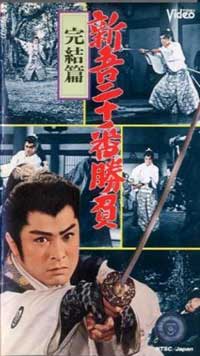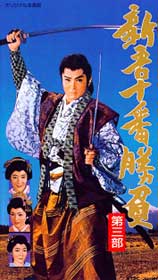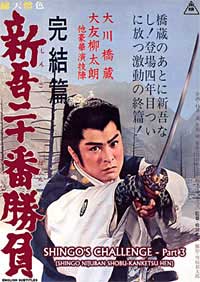The story of Shingo Aoi, bastard son of the Shogun (Ryotaro Otomo), is one of the most beautifully filmed if nonsensically plotted series of all time. The final episode, attempting to tie up loose ends from previous films, is non-stop illogical action, if it is taken as a whole, but gorgeous cinematic mayhem if taken scene by scene.
Directed by Sadatsuga (Teiji) Matsuda & based on a story by Matsutaro Kawaguichi, Shingo's Twenty Challenges: Final Chapter (Shingo nijuban shobu: kanketsu-hen, 1963) continues the starring vehicle for superstar Hashizo Okawa, one of the most beautiful (in an almost feminine sense) chambara actors ever to grace the wide screen.
 Like the other episodes, the beginning credits appear against images from Buddhist scroll art, while a rather sacred-sounding theme is sung by a choir. The choice of art for Shingo's Twenty Challenges III is a hell-scroll showing humanity's vices & punishments among flames & devils. Like the other episodes, the beginning credits appear against images from Buddhist scroll art, while a rather sacred-sounding theme is sung by a choir. The choice of art for Shingo's Twenty Challenges III is a hell-scroll showing humanity's vices & punishments among flames & devils.
A voice-over reminds us of the continuing motif of Shingo's path which veers ever away from love & happiness & toward the strict & painful road of swordsmanship. He may believe his path was intellectually chosen, but it is in reality the result of karma accumulated in former lives, holding him back from achieving a greater enlightenment.
The fencers Shingo Aoi has most admired, Umei Tamon & Mazaki Shozaburo, fell to defeat. He begins to wonder whether swordsmanship is "a path without salvation." Should he give up the sword? Lacking any confidente with whom to address his doubts, he climbs snowy Mount Yakushigatake, seeking the old hermit-swordsman Notomi Ichimusai for guidance.
Thus as the story opens, young Shingo is crossing snow-covered alps to see sensei Notomo, but finds a skeleton instead. Horrified to realize "This is the sight of a man who lived only for fencing!" he flees the dead man's hut, becomes lost & snowblind, & falls into a crevass.
There he lays half conscious, sighing & turning his body in phenomenally sexy postures usually associated in cinema with fainting women. It is in scenes like this that a viewer may suddenly remember that Hashizo Okawa is intentionally playing Shingo Aoi as a young man with a girl's soul.
Hahizo stated this as having been his intention from the start, as it would take advantage of his own girlish beauty, & his training in the kabuki theater as an onnagata (player of female roles). While he was at it he even designed his own costumes so that Shingo would appear to be just slightly intergendered in dress. Hair style also plays into the girlishness that is one element of Hashizo's conceptual expression of Shingo.
That certainly is not the only character trait, as through the series Shingo is also something of a petulant spoiled little boy who, finding it impossible to have everything he wants in this world, throws tantrums of the worst sort.
 But for the moment, swooning in the crevass, his masculinity is nearly eradicated. But for the moment, swooning in the crevass, his masculinity is nearly eradicated.
As he suffers & moans in the depths, he inexplicably sees Koi, his mother, looking over him like a bodhisattva. The story immediately cuts to Koi & her handmaiden Nui. Koi has dreamed her son needs help, & so prays to Kannon the Goddess of Mercy to save him from the snowy crevass she dreamed about.
There then follows a didactic conversation between Koi & Nui intended to synopsize events from previous episodes for whoever didn't see them or may have forgotten:
Koi, although she is the mistress of the Shogun & loves him more than not, had recently attempted to assassinate him in order to avenge her father whom the Shogun killed so many years before, so now she & Nui have been sent away into semi-seclusion.
The shogun's rape of Koi two decades prior resulted in the subsequent birth of Shingo, whose existence is a threat to Tokugawa heirs. This is why Shingo was raised in a far province, knowing neither his true father nor his mother.
We also learn that the Shogun loves Koi & would like to love Shingo if his illegitimate son would only ask personally for an audience. But Shingo is too proud to do that. Thus he wanders alone, hoping to achieve something without the aid of his vastly important pappy; plus, being a momma's boy at heart, dreaming of the day that he can be with his mum.
After this updating opening, the film procedes to introduce or re-introduce from previoius films a wide array of characters. There is Isshin Takedo of the Yagyu clan, Shingo's sworn enemy & fencing equal, whose secret style involves fighting blindfolded or with eyes closed. He's one of the story's best characters, excellently played by Ryunosuke Tsukigata.
Then there's Utonosuke, the mountain girl with a boy's name, who wants to be Shingo's pupil & become a great swordswoman. Shingo may admire her primitive skill, but he's a chauvenist at heart, & says, "I can't have a woman for a pupil." She insists, "I'm not a woman! I'm Itonosuke!"
This charming character alas will turn out to be a Yagyu spy. Of course she falls in love with Shingo though she's not supposed to. What is more surprising, Shingo falls in love with her. He has had two love interests in previous episodes, but his love was like that of a brother, not a lover, to those women's frustration. In Shingo's Challenge II he openly questions his own sexuality, unable as he to bond with any woman like a normal heterosexual man.
This time he feels himself truly & for the first time in love with a woman. That she dresses & acts like a boy makes her his direct counterpart, two gender-bent beauties who match up perfectly.
That Shingo will end up accidentally killing her father is just one of many events that show Shingo's obssession for the sword to be ill considered. As for Utonosuke herself, she'll get in some pretty good fighting with tanto (knife) before meeting her own fate.
There is the dirty, noxioius Fudo Kanzan whose kusari-gama (sickle & chain) lends grand power to some of the film's best fight sequences. He'll turn out to be Utonosuke's long lost father, as coincidences of that sort abound in the unbelievable plot.
There is Priest Kotoku who wants to save Shingo form his violent road, teaching him that people grieve even for the bad people Shingo kills. It seems a simple enough message, that killing is wrong, but a hard one for a swordsman to embrace.
And there is the wandering monk Umei Tamon (Isao Yamagata) who has the name & face of a man Shingo knows to be dead, a man he grew up thinking of as his father, so it's quite an emotional whammy to see him alive.
Monk Tamon laughs at Shingo's shock of recognition, explaining, "I am his brother." He has taken the dead man's identity in order to work off his brother's sins on a perpetual pilgrimage. "I have been looking for you a long while," he tells Shingo, "to ward off Tamon's demon soul."
Tamon in the first two episodes of Shingo's Original Challenge (Shingo juban shobu, I, II,1959) Tamon was one of the "good" guys, but obsessed, like Shingo himself, with swordsmanship, which he pursued right into his own grave. Now his twin brother shows up to impart the Buddhist message that Tamon's obsession was evil, & this evil has been passed on to Shingo, causing his misguided belief that swordsmanship is holy & good though it is really just for killing. And even when bad people are killed, good people will suffer.
Between the priest & the monk, Shingo's journey takes on an increased mystical consequence, as all things that happen appear karmic in origin. Monk Tamon devoutly believes in Shingo as a bodhisattva: "You were not born to be a fencer. You were born for the world's salvation. You are a Buddhist saint."
But no man can believe such a thing of himself, & Shingo exclaims, rather horrified, "That's ridiculous!" To imagine otherwise would mean giving up all that he had devoted his life to achieving.
Typical of the story's tone is the sequence wherein Shingo saves pilgrims from a band of thieves. They escape with money belonging to a widow, but pure-&-wholesome Shingo gives her money of his own.
He then discovers that her proverty is the result of his having killed her husband Kitagawa Tanomo in a previous movie. Emotionall tormented Shingo is left to wonder, "Can't fencing be salvation?"
The scene following has him captured by musket-armed brigands who take him to a toothy cavern (another stylized gorgeous set like the mountain crevass earlier) where he meets the leader of the brigands, Princess Shizo.
These thieves, initially introduced as likely bad-guys, turn out to be the faithful retainers of a woman who has fallen from on high because Shingo killed her father. They live miserably in a cave because the clan was abolished after Shingo killed Inoue Kawachi.
This theme is repeated a number of times until near the end when Shingo is confronted by all the grieving people who have come to Priest Kotoku's temple to attend special services for relatives slain by Shingo Aoi.
These indirect victims of Shingo's violence do not seek revenge. They are after re-establishment of their families, meaning Shingo must ask his father's favor, though he has vowed never to do so.
He finally agrees to see the Shogun personally & ask that he help these people. But enemies fear the Shogun will make Shingo heir, so that Shingo is cast into a massive battle during which he shouts, "I'll survive & see my mother!"
Meanwhile, his mother Koi has set out on a pilgrimage afoot, with her handmaiden Nui in tow. She is in part looking for Shingo, but mainly she wants to understand him by being on the road as he has been.
Koi feels she can never understand her son if she lives luxuriously. She also feels she must do penance for her sin of never having avenged her own father, but instead loving her family's foe.
She prays for Shingo's salvation at shrines along the way, desiring nothing for herself except to meet her son once more before she dies.
The Shogun forgiving her attempt at killing him begged her to return to the inner court. He feels her preference for hardship on the road to be a cruel rebuff, punishment for his having killed her father those twenty years before. It had been done over a slight breach of ettiquette legally punishable by death. He's a more merciful man now, but knows he caused great pain to Lady Koi, & deserves blame.
The bitter swordmaster Takeda Isshin is the Shogun's personal sword instructor. The Shogun has no idea that this man has long nurtured a grudge against Shingo & sent Yagyu spies to assassinate the young man. They repeatedly failed, so he intends to do it himself.
He tests himself while blindfolded against unblindfolded opponents. When he reaches the stage where he can kill a man without needing to see, he feels he is ready for a rematch with the young man who won from him the title of Japan's Number One Swordsman.
Ambushed by Takeda Isshin & his men, Shingo easily kills everyone except his old rival, who indeed has improved his abilities so that Shingo can no longer out-fence him. Had not the Yagyu woman spy Utonosuke intervened with a knife tossed in Takeda Isshin's eye, Shingo would have been killed.
He now realizes he must train for the inevitable next meeting with Takeda, which will be one of the crowning duels of the whole series.
Shingo's mother's hardship-pilgrimage made her ill. She has taken to a bed & is expected to die. Upon her death-bed, Shingo finally is united with her, & his mere presence miraculously cures her, indeed brings her back from having already that minute died. It's a kid's film after all, & on some level they are both of them Buddhist divinities.
As he has at long last learned there is no salvation in violence, & anyway he loves his mommy more than he loves his sword, he gives up his life as a swordsman vowing to live with her forever, like a dutiful spinster daughter.
A cut to the Shogun's palace reveals the Shogun's acceptance of Koi's desire to live with Shingo instead of him. He hopes that they will be happy together though he can never again see son or mistress.
The closing shot is a happy-happy-joy-joy ending with Shingo, now dressed as a peasant, & his mom on a hillside together, gazing into each other's eyes. And yes, it's kind of sicko, but remember, Shingo's got a girl's soul, so his is like a daughter's love, muting the oedipal fantasy.
The convoluted plot-line when sorted out never makes a heck of a lot of sense, hanging as it does on coincidences which greatly test one's ability to suspend disbelief with the recurring explanation "It's karma" & karma is like magic. It can sometimes seem a bit silly, yet the beauty of the costuming & sets, not to mention of the players in their roles & most especially Hashizo Okawa, makes Shingo's biography a wonder to behold upon the screen.
copyright © by Paghat the Ratgirl
|

